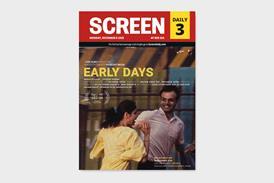
Mk2’s documentary feature about a French YouTube star climbing Mount Everest has become an event film box-office phenomenon in France with 368,000 tickets sold in 24 hours, but has ignited a backlash from the local industry.
The film was able to skip France’s media chronology trajectory by obtaining an “exceptional visa” from the CNC allowing the film to screen in cinemas for a maximum 500 times.
However, mk2 could be slapped with a €45,000 fine since the film ended up playing on nearly double the allotted allowance. A French court will have the final word on the specific sanctions.
The film’s unconventional release – additionally, it will air on broadcaster TF1 on October – and subsequent success have incited heated debates as the country’s top distributors, exhibitors and industry figures gather in Deauville for the annual FNCF conference.
Kaizen: 1 Year To Climb Everest!, about 22 year-old social media star Inoxtag’s ascent of the world’s highest peak, sold an estimated 310,000 tickets in France and the rest in overseas territories on some 800 screens on September 13 and 14.
The figures are all the more impressive since Kaizen was then released on YouTube for free the following day where it was viewed more than 11 million times in its first 24 hours.
Its two-day admissions tally is the best for an event film in France to date. “This has never happened anywhere ever. It’s the first time in the world there was a release in cinemas, then the next day on YouTube for free,” said mk2’s co-CEO Elisha Karmitz.
Social media star

Inoxtag is the pseudonym of Inès Benazzouz who boasts 8 million subscribers on YouTube, 5.9 million on TikTok and 5.2 million on Instagram. He produced the doc with executive producers Samy Bouyssié and Webedia Group’s IDZ Prod.
Kaizen sold 200,000 tickets in the 10 days preceding its launch. As soon as pre-sales kicked off online, sites for major groups including Pathé, UGC and Kinepolis crashed, according to Karmitz, in “a tidal wave of clicks”.
Allocine said its website clocked 1.5 million hits for the film’s web page alone between 5pm and midnight that day. Karmitz called it “the Taylor Swift effect in France”.
Mk2 maintains it had initially planned to release on just 350 screens, but that demand led many cinemas to programme more screenings not directly authorised by the distributor.
“All of the sites crashed so we didn’t have any visibility. Theatre owners were calling us to programme more screenings, some we approved, but most we didn’t.”
By the time the tickets were booked, mk2 says it was too late to reimburse filmgoers.
Gamechanger?
The issue has generated heated debates as exhibitors and distributors gather in Normandy for the FNCF’s week-long series of conferences and screenings.
Olivier Snanoudj, Warner Bros Discovery head of theatrical distribution for France and Benelux, addressed a room of industry professionals on Wednesday (September 25) to express his “sentiment of frustration and injustice”, comparing mk2 to “guys in hoodies with machine guns robbing a bank” – albeit “robbers with big hearts”.
Snanoudj argued, “It wasn’t this screening that brought young audiences back to cinemas. It’s what we do from January 1 to December 31.” He accused mk2 of “doing whatever they want” and warned other distributors: “Be careful not to compromise your principles and values for just one screening.”
Karmitz described Snanoudj’s comments as “excessive”. “We’re the scapegoat of this phenomenon, but there was no legal or administrative way to get around what happened. It was out of our hands.”
The mk2 executive maintains that surpassing the mandated 500 screens was not pre-meditated: “Even the night before the screening, Inoxtag himself was writing to me wondering if anyone would show up. We could not have predicted this.”
The issue has also thrown the country’s media chronology and strict windowing regulations back into the spotlight.
In France, since January 2022, films released theatrically must respect a precise timetable and can be released after four months on TVoD, six months on pay-TV leader Canal+, 15 months on Netflix and 17 months on other streamers like Prime Video, Max and Disney+. After 22 months, they can then be shown on linear TV broadcasters.
The current chronology, long defended by local distributors, exhibitors and broadcasters, and protested by the US streamers and studios, is up for renewal in January 2025, though the concerned parties have yet to negotiate new measures.
Currently, three types of “exceptional visas” to bypass the current windowing system exist and the one obtained for Kaizen allows a film to be shown for a maximum of two days over the course of one week and for a ceiling of 500 total screenings. To date, 39 films have received a temporary visa since 2022 representing just 0.07% of total screenings and 0.15% of moviegoers for the 2022-2023 period.
The “exceptional visa” approved by the CNC gave mk2 the right to distribute the film in theatres on September 13-14, and Karmitz insists the company’s financial stake or interest in subsequent revenue streams from TF1 or YouTube ads is “zero”.
Next steps
Olivier Henrard, managing director and acting president of the CNC, also weighed in during the Deauville debate and confirmed he has invoked judicial authorities who will decide on the precise punishment.
He called the surplus of screenings for Kaizen “regrettable”, adding that “the law is the law” and also accused mk2 of “a violation that was deliberate and programmed in advance”. He said he will not put the brakes on temporary visas, which he branded “very useful and adapted to our times”, but added that the CNC plans to work to “adapt the rules to make them better… in the next two or three weeks”.
Karmitz confirmed that mk2 is not contesting the fine, but takes umbrage that “we are being accused of deliberately breaking the law”.
“We wanted to show that young people today have new ways of consuming content and that artists from the creators’ economy are here and our industry should learn from them.”
























No comments yet